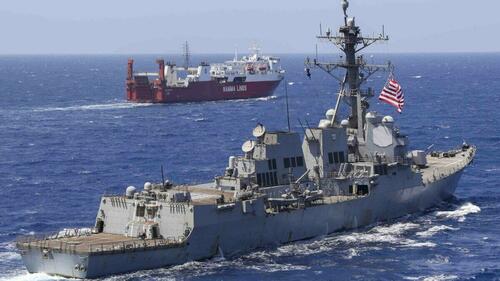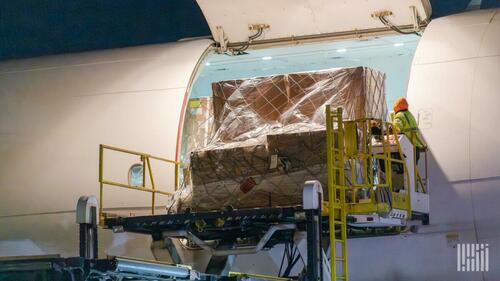
By Eric Kullisch of FreightWaves
Global businesses, uncertain how long the shipping crisis in the Red Sea will last and with a looming shortage of vessels for the export rush before China’s New Year celebration, are scrambling to shift some ocean cargo to airlines, according to logistics specialists.

Major container lines have rerouted vessels around the Horn of Africa or docked them in safe locations to avoid the threat of drone and missile attacks by Yemen’s Iran-backed Houthi rebels in the Red Sea and Gulf of Aden. The Houthis say they are targeting vessels with links to Israel in support of Palestinians under siege in the Gaza Strip. Thirty percent of container volumes transit the Red Sea and Suez Canal shortcut between Europe and Asia.
The strikes on commercial shipping come as drought conditions force the Panama Canal, another trade chokepoint, to limit transits because of insufficient water to operate massive locks. Some vessel operators recently shifted services to the Suez route to avoid Panama transit delays and now are in a double bind.
With no end in sight to the Gaza war and tensions rising, air cargo providers could see a surge in business following a prolonged market downturn that only lifted in recent months behind rising e-commerce exports from China for the holidays.
“The e-commerce wave just broke and rates began crashing down this week. We expect the Red Sea shipping crisis will reverse this,” Marc Schlossberg, executive vice president at Unique Logistics International, told FreightWaves. “We are already seeing an impact on airfreight across multiple regions, industries, and supply chains. Some retailers are already flipping cargo bound for the U.S. East Coast from ocean to air from the Indian subcontinent as there are no good options that do not add two weeks. We have other customers assessing their needs to the U.K. and Europe from Asia.”
Shipping experts say diversion around the Cape of Good Hope, which adds seven to 14 days’ sailing time to Europe and five to seven days to the U.S. East Coast, has unleashed a chain reaction that includes knocking vessels off scheduled arrivals, vessel bunching in ports, terminal congestion and difficulty repositioning containers around the world. Transits could be longer in some cases because the tip of Africa often has rough seas and storms.
Vessels returning to reload with factory goods in Asia will now arrive a couple of weeks late for the seasonal pickup before Chinese New Year, which will result in a shortfall of shipping capacity, said Lars Jensen, CEO of consultancy Vespucci Maritime, on a Wednesday webinar presented by freight forwarder Flexport.
Chinese New Year falls on Feb. 10, but factories will begin to slow production in mid-January before completely shutting down for the holiday and then slowly ramping up again — a lull that can last more than a month. Businesses pull forward their shipping requirements each year, which leads to a rush at Chinese ports, transportation delays and increased shipping rates.
About 540 vessels are assigned to Suez services, with 136 currently being diverted around Africa and 42 that have paused their journey, according to a Flexport analysis.
Chicago-based Seko Logistics has had some inquiries about converting ocean shipments to air leading up to the Chinese holiday, “but this could very well extend and expand into 2024,” said Chief Commercial Officer Brian Bourke in an email.
About 97% of total containerized trade by weight moves by sea, so even a slight shift in the mix could have a huge impact on airfreight volumes.
Importers and exporters will likely transition their most critical goods to air carriers to make sure enough arrive on time for production or sales needs, especially since many flights from Asia to Europe are still quite full, Niall van de Wuow, chief airfreight officer at market intelligence firm Xeneta, said on a company webinar.

“I had a call with a global appliance company with sites around the world. Airfreight is cheaper than lines down. We expect to see an airfreight surge for manufacturing as automotive, electronics and other supply chains assess their inventory needs in the next few days,” said Schlossberg.
“We have customers searching for solutions from Egypt where the ports have been shut down and from Jordan where customers are not comfortable with the cross-border option. And ocean routing via Israel and Aqaba is no longer viable,” he added.
Companies spent the better part of a year bringing down excess pandemic inventories to normal levels and may not have sufficient safety stock if the Red Sea bottleneck continues to disrupt shipping, said Trine Nielsen, Flexport’s head of ocean for Europe, the Middle East and Asia. She encouraged shippers to plan for extra lead times and rate increases, and to book shipments early.
“Most of our fashion apparel retail customers had a strong holiday season. Inventories are in relatively good shape so a disruption like this will drive significant airfreight demand,” echoed Schlossberg.
There is less urgency to make mode-conversion decisions because the industry is past the Christmas shopping rush, but that will quickly change without a resolution of the Middle East conflict, according to logistics managers.
The airfreight market could get heated by mid-January as importers place new orders with Asia suppliers, especially since many airlines reduced freighter schedules in anticipation of a lull in transport demand, said Christos Spyrou, founder and CEO of wholesale network Neutral Air Partner.
He predicted an increase in charter flights to meet demand, especially for time-critical and valuable goods, as well as more use of sea-air services via Dubai to Europe. Flexport, which helps companies place orders with overseas manufacturers and then manages shipment delivery, has also fielded inquiries about deferred airfreight and sea-air options through Dubai and Doha, Qatar, said Zeid Houssami, global head of airfreight, in an email.
The hybrid services are less expensive than airfreight but faster than ocean.
Air capacity on the trans-Pacific might get tighter after Chinese New Year if ocean carriers divert vessels to Asia-eastbound lanes to provide more reliability, Houssami observed.
Open-ended risk to ocean shipping
The Suez route attracts a high proportion of the world’s largest vessels. Peter Sand, Xeneta’s chief data analyst, said shipping lines need 50 more ultralarge container ships on the eastbound corridor. Ship broker Clarksons estimates that 19% of global shipping capacity will be diverted from the Suez route.
Carriers have idle capacity at the moment, but not all vessels are suitable or can easily be restarted.
In addition to dealing with heightened supply chain uncertainty, shippers will face higher transportation costs because of the diversion of shipping away from the Red Sea.
For starters, adding ships to move the same amount of containers means spending for extra crews, fuel, supplies, port charges and other expenses. If smaller ships are deployed they will have higher unit costs per nautical mile.
Carriers will save $400,000 to $700,000 in Suez Canal tolls, but the 3,000 extra nautical miles to go around Africa to Europe will add $1 million in fuel costs per vessel, which will be passed on to customers, Sand explained.
Liner companies ZIM, Hapag-Lloyd and Maersk are now charging a war risk surcharge of between $20 and $100 per container and ZIM is charging more for the longer route around Africa.
Shipping line CMA CGM this week declared force majeure and implemented surcharges of up to $1,550 per container unit, depending on the origin and destination. Invoking a force majeure clause tells customers the carrier may not be able to fulfill contractual obligations due to circumstances beyond its control.
The formation of a multinational task force, led by the U.S., to protect commercial shipping is unlikely to alleviate the risk of attacks, prolonging the disruptive effects on supply chains, maritime experts say.
Partner nations have previously escorted convoys to defend vessels against hijacking by Somali pirates, but air attacks present another level of danger for commercial operators. Participating navies may not have the right kind of anti-missile technology and no system is foolproof.
Vespucci Maritime’s Jensen said small drones may not seem like a major threat to massive container ships but noted the danger from an explosion is fire that could quickly spread.
“Are you going to risk life and limb of your seafarers and a billion dollars worth of cargo on the ship in the hope that they will shoot down all of those missiles? … Unless there is also a solution whereby the attacks themselves from land stop, or at least are eliminated drastically, I have a hard time seeing the carriers resume sending supersized post Panamax vessels through that region,” he said.
The biggest shipping problem will be in the Mediterranean Sea because carriers that used to call on ports such as Genoa in Italy, on their way to major gateways in Northern Europe, will bypass the smaller destinations, said Jensen.
Shippers should also brace for Med-bound containers to get stuck for up to a week in unfamiliar transshipment ports such as Tangiers in Morocco or Algeciras in Spain, where carriers will offload them to avoid lengthy detours from the main route.
Jensen also warned that some consumer goods may swing back to the Panama Canal, pricing out Chilean and Peruvian agriculture growers who are less able to pay the reservation fees for priority access.
Shippers that bring products to the East Coast through the Suez Canal also have the option of using the trans-Pacific route and then moving inland by rail or truck.
Jensen said the combination of strong Chinese New Year demand and the effective decrease in global container capacity because of the extra ships necessary to sustain diversion around Africa could lead ocean rates to triple. Interviewed on CNBC on Friday, Jensen predicted the average global rate would double to about $3,000.
Ocean rates are already spiraling upward. The rate for a forty-foot equivalent unit reached $1,875 between Asia and the Mediterranean on Dec. 14, according to the Xeneta platform – a 25% increase from the previous week. But shippers are being quoted more than $6,500 for high priority shipments on Mediterranean Shipping Company’s Diamond Tier service. And MSC implemented peak season surcharges of $2,000 for Asia-Mediterranean cargo.
And, Jensen noted, a new European emissions trading scheme for maritime that is scheduled to go into effect on Jan. 1 will be much for expensive as carriers have to pay carbon tax on emissions for going all the way around Africa.
By Eric Kullisch of FreightWaves
Global businesses, uncertain how long the shipping crisis in the Red Sea will last and with a looming shortage of vessels for the export rush before China’s New Year celebration, are scrambling to shift some ocean cargo to airlines, according to logistics specialists.

Major container lines have rerouted vessels around the Horn of Africa or docked them in safe locations to avoid the threat of drone and missile attacks by Yemen’s Iran-backed Houthi rebels in the Red Sea and Gulf of Aden. The Houthis say they are targeting vessels with links to Israel in support of Palestinians under siege in the Gaza Strip. Thirty percent of container volumes transit the Red Sea and Suez Canal shortcut between Europe and Asia.
The strikes on commercial shipping come as drought conditions force the Panama Canal, another trade chokepoint, to limit transits because of insufficient water to operate massive locks. Some vessel operators recently shifted services to the Suez route to avoid Panama transit delays and now are in a double bind.
With no end in sight to the Gaza war and tensions rising, air cargo providers could see a surge in business following a prolonged market downturn that only lifted in recent months behind rising e-commerce exports from China for the holidays.
“The e-commerce wave just broke and rates began crashing down this week. We expect the Red Sea shipping crisis will reverse this,” Marc Schlossberg, executive vice president at Unique Logistics International, told FreightWaves. “We are already seeing an impact on airfreight across multiple regions, industries, and supply chains. Some retailers are already flipping cargo bound for the U.S. East Coast from ocean to air from the Indian subcontinent as there are no good options that do not add two weeks. We have other customers assessing their needs to the U.K. and Europe from Asia.”
Shipping experts say diversion around the Cape of Good Hope, which adds seven to 14 days’ sailing time to Europe and five to seven days to the U.S. East Coast, has unleashed a chain reaction that includes knocking vessels off scheduled arrivals, vessel bunching in ports, terminal congestion and difficulty repositioning containers around the world. Transits could be longer in some cases because the tip of Africa often has rough seas and storms.
Vessels returning to reload with factory goods in Asia will now arrive a couple of weeks late for the seasonal pickup before Chinese New Year, which will result in a shortfall of shipping capacity, said Lars Jensen, CEO of consultancy Vespucci Maritime, on a Wednesday webinar presented by freight forwarder Flexport.
Chinese New Year falls on Feb. 10, but factories will begin to slow production in mid-January before completely shutting down for the holiday and then slowly ramping up again — a lull that can last more than a month. Businesses pull forward their shipping requirements each year, which leads to a rush at Chinese ports, transportation delays and increased shipping rates.
About 540 vessels are assigned to Suez services, with 136 currently being diverted around Africa and 42 that have paused their journey, according to a Flexport analysis.
Chicago-based Seko Logistics has had some inquiries about converting ocean shipments to air leading up to the Chinese holiday, “but this could very well extend and expand into 2024,” said Chief Commercial Officer Brian Bourke in an email.
About 97% of total containerized trade by weight moves by sea, so even a slight shift in the mix could have a huge impact on airfreight volumes.
Importers and exporters will likely transition their most critical goods to air carriers to make sure enough arrive on time for production or sales needs, especially since many flights from Asia to Europe are still quite full, Niall van de Wuow, chief airfreight officer at market intelligence firm Xeneta, said on a company webinar.

“I had a call with a global appliance company with sites around the world. Airfreight is cheaper than lines down. We expect to see an airfreight surge for manufacturing as automotive, electronics and other supply chains assess their inventory needs in the next few days,” said Schlossberg.
“We have customers searching for solutions from Egypt where the ports have been shut down and from Jordan where customers are not comfortable with the cross-border option. And ocean routing via Israel and Aqaba is no longer viable,” he added.
Companies spent the better part of a year bringing down excess pandemic inventories to normal levels and may not have sufficient safety stock if the Red Sea bottleneck continues to disrupt shipping, said Trine Nielsen, Flexport’s head of ocean for Europe, the Middle East and Asia. She encouraged shippers to plan for extra lead times and rate increases, and to book shipments early.
“Most of our fashion apparel retail customers had a strong holiday season. Inventories are in relatively good shape so a disruption like this will drive significant airfreight demand,” echoed Schlossberg.
There is less urgency to make mode-conversion decisions because the industry is past the Christmas shopping rush, but that will quickly change without a resolution of the Middle East conflict, according to logistics managers.
The airfreight market could get heated by mid-January as importers place new orders with Asia suppliers, especially since many airlines reduced freighter schedules in anticipation of a lull in transport demand, said Christos Spyrou, founder and CEO of wholesale network Neutral Air Partner.
He predicted an increase in charter flights to meet demand, especially for time-critical and valuable goods, as well as more use of sea-air services via Dubai to Europe. Flexport, which helps companies place orders with overseas manufacturers and then manages shipment delivery, has also fielded inquiries about deferred airfreight and sea-air options through Dubai and Doha, Qatar, said Zeid Houssami, global head of airfreight, in an email.
The hybrid services are less expensive than airfreight but faster than ocean.
Air capacity on the trans-Pacific might get tighter after Chinese New Year if ocean carriers divert vessels to Asia-eastbound lanes to provide more reliability, Houssami observed.
Open-ended risk to ocean shipping
The Suez route attracts a high proportion of the world’s largest vessels. Peter Sand, Xeneta’s chief data analyst, said shipping lines need 50 more ultralarge container ships on the eastbound corridor. Ship broker Clarksons estimates that 19% of global shipping capacity will be diverted from the Suez route.
Carriers have idle capacity at the moment, but not all vessels are suitable or can easily be restarted.
In addition to dealing with heightened supply chain uncertainty, shippers will face higher transportation costs because of the diversion of shipping away from the Red Sea.
For starters, adding ships to move the same amount of containers means spending for extra crews, fuel, supplies, port charges and other expenses. If smaller ships are deployed they will have higher unit costs per nautical mile.
Carriers will save $400,000 to $700,000 in Suez Canal tolls, but the 3,000 extra nautical miles to go around Africa to Europe will add $1 million in fuel costs per vessel, which will be passed on to customers, Sand explained.
Liner companies ZIM, Hapag-Lloyd and Maersk are now charging a war risk surcharge of between $20 and $100 per container and ZIM is charging more for the longer route around Africa.
Shipping line CMA CGM this week declared force majeure and implemented surcharges of up to $1,550 per container unit, depending on the origin and destination. Invoking a force majeure clause tells customers the carrier may not be able to fulfill contractual obligations due to circumstances beyond its control.
The formation of a multinational task force, led by the U.S., to protect commercial shipping is unlikely to alleviate the risk of attacks, prolonging the disruptive effects on supply chains, maritime experts say.
Partner nations have previously escorted convoys to defend vessels against hijacking by Somali pirates, but air attacks present another level of danger for commercial operators. Participating navies may not have the right kind of anti-missile technology and no system is foolproof.
Vespucci Maritime’s Jensen said small drones may not seem like a major threat to massive container ships but noted the danger from an explosion is fire that could quickly spread.
“Are you going to risk life and limb of your seafarers and a billion dollars worth of cargo on the ship in the hope that they will shoot down all of those missiles? … Unless there is also a solution whereby the attacks themselves from land stop, or at least are eliminated drastically, I have a hard time seeing the carriers resume sending supersized post Panamax vessels through that region,” he said.
The biggest shipping problem will be in the Mediterranean Sea because carriers that used to call on ports such as Genoa in Italy, on their way to major gateways in Northern Europe, will bypass the smaller destinations, said Jensen.
Shippers should also brace for Med-bound containers to get stuck for up to a week in unfamiliar transshipment ports such as Tangiers in Morocco or Algeciras in Spain, where carriers will offload them to avoid lengthy detours from the main route.
Jensen also warned that some consumer goods may swing back to the Panama Canal, pricing out Chilean and Peruvian agriculture growers who are less able to pay the reservation fees for priority access.
Shippers that bring products to the East Coast through the Suez Canal also have the option of using the trans-Pacific route and then moving inland by rail or truck.
Jensen said the combination of strong Chinese New Year demand and the effective decrease in global container capacity because of the extra ships necessary to sustain diversion around Africa could lead ocean rates to triple. Interviewed on CNBC on Friday, Jensen predicted the average global rate would double to about $3,000.
Ocean rates are already spiraling upward. The rate for a forty-foot equivalent unit reached $1,875 between Asia and the Mediterranean on Dec. 14, according to the Xeneta platform – a 25% increase from the previous week. But shippers are being quoted more than $6,500 for high priority shipments on Mediterranean Shipping Company’s Diamond Tier service. And MSC implemented peak season surcharges of $2,000 for Asia-Mediterranean cargo.
And, Jensen noted, a new European emissions trading scheme for maritime that is scheduled to go into effect on Jan. 1 will be much for expensive as carriers have to pay carbon tax on emissions for going all the way around Africa.
Loading…






